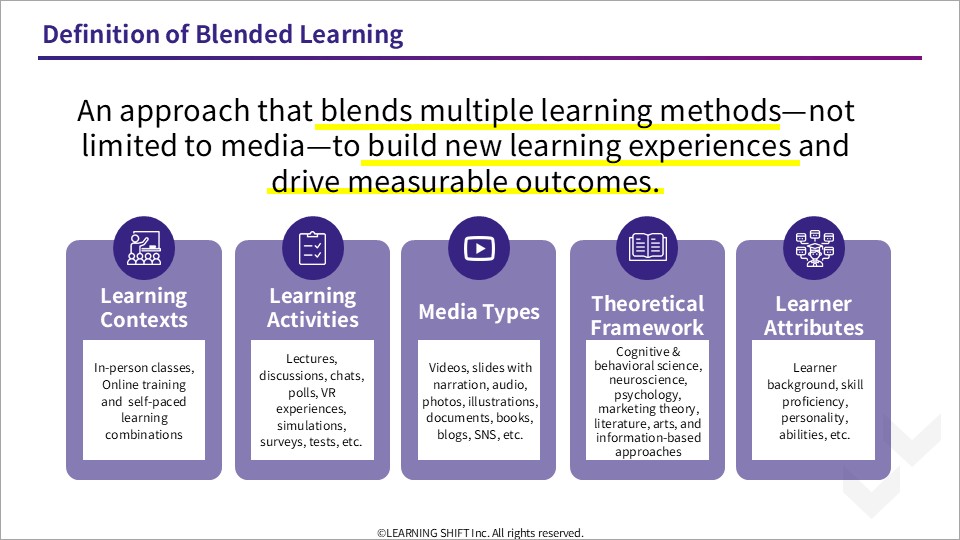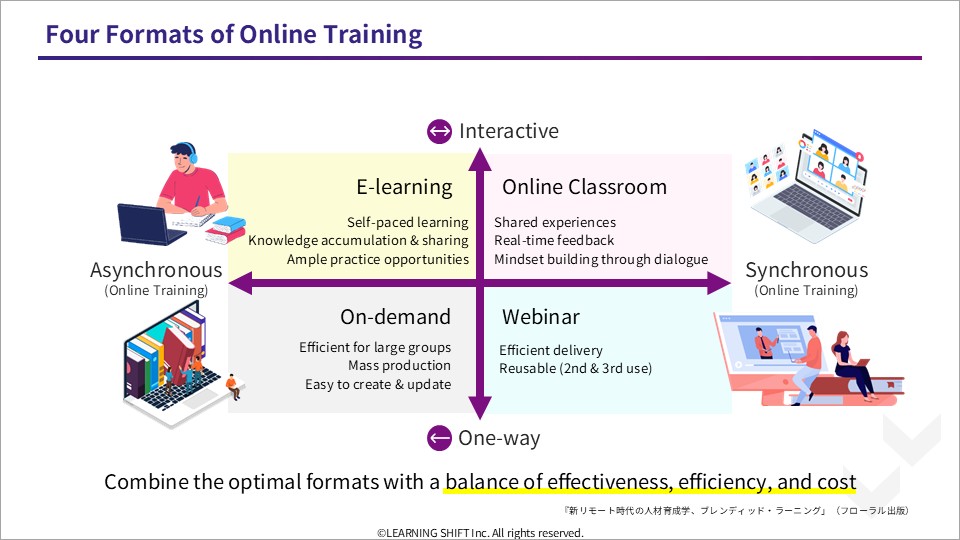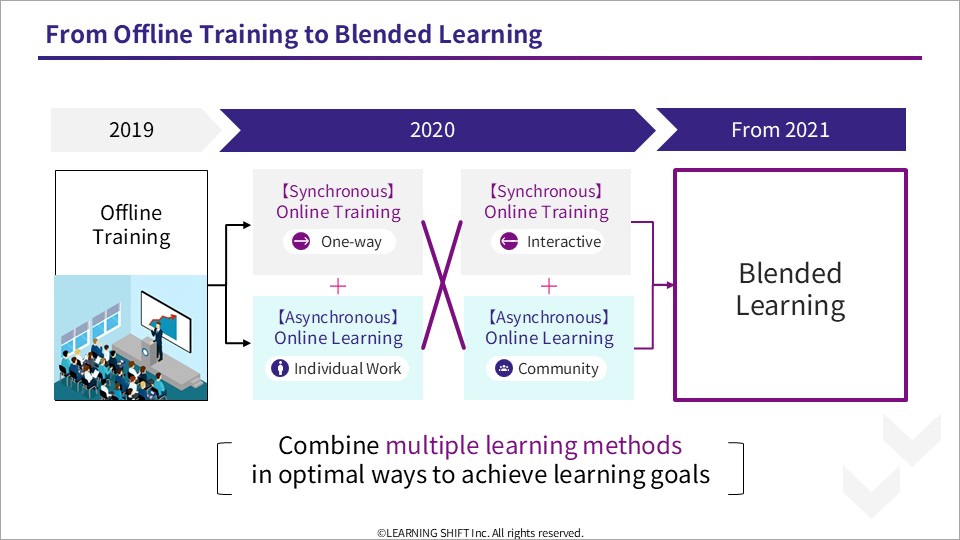2022.02.01
Blended Learning in the Spotlight: Key Features and Growing Importance Amid the Rapid Shift to Online Training

Amidst these challenges, blended learning has gained attention as a promising approach. You may be wondering, "Why is it important now?" and "Can it truly deliver high learning performance?" In this article, we will discuss the characteristics of blended learning, its growing importance, and the context behind its rise.
1. What is Blended Learning?
Blended learning refers to a learning method that blends multiple learning modalities, incorporating technology to enhance the learning process.
Traditional training primarily involved in-person sessions where instructors guided participants in a classroom setting. However, blended learning combines various formats, such as in-person workshops with eLearning modules, to create new and more flexible learning programs.
#1 – 1|The 5 Key Elements Blended Learning Combines
The “blended” nature of blended learning can be categorized into the following five major elements:
- Media (Learning materials): Books, videos, illustrations, photos, blogs, social media, etc.
- Learning Activities (Methods of learning): Lectures, dialogues, chats, polls, simulations (e.g., VR), mock experiences, etc.
- Learners (The people learning): Background, skill level, personality, industry, experience, and abilities.
- Theory (Theories behind the methods): Cognitive science, behavioral science, neuroscience, psychology, marketing theories, emotional approaches (e.g., art), etc.
- Delivery Methods (Modes of learning): Online learning, online workshops, in-person group sessions (offline learning), etc.
While the fifth element—mode of delivery—is commonly associated with blended learning, even aspects such as including feedback from supervisors and colleagues in new employee training can be considered part of this blend.

#1 – 2|Features of Blended Learning Programs
Blended learning is not just about combining different learning elements. It is about aligning the strengths of each component with the training goals to create the most effective learning program.
For instance, in in-person group training, the benefit lies in real-time interactions between instructors and participants. When blended with online learning, it allows for pre-session eLearning modules and post-session group activities, which significantly enhance the learning outcomes. Additionally, this combination of online and offline elements can reduce costs while still improving learning effectiveness.
The key feature of blended learning lies in its ability to combine the “best of both worlds” and tailor the experience to the needs of the learners.
2. Why is Blended Learning Important Now?
The growing importance of blended learning can be traced back to the development of digital transformation (DX).
The term “DX” was first introduced in the 2004 paper “Information Technology and the Good Life,” by Professor Eric Stordahlman of Umeå University in Sweden. He explained that digital transformation refers to the changes in all aspects of human life induced by advancing digital technologies.
DX covers a wide range of fields but has particularly impacted economic activities.
#2 – 1|The Role of DX in Businesses and the Increasing Importance of Learning DX
According to Japan’s Ministry of Economy, Trade, and Industry, DX is defined as:
“The process by which companies respond to rapid changes in the business environment and transform their products, services, business models, operations, organizations, processes, corporate culture, and more by leveraging data and digital technologies, ultimately establishing a competitive edge.”
The goal of DX in businesses is to establish a competitive advantage, and leveraging digital technology is the means to achieve that. One of the first areas companies need to address in their DX efforts is the digital transformation of learning and development.
There are four key reasons why the digitalization of learning is critical:
- To provide employees with the skills required for new roles.
- To communicate the company’s vision and ensure employees act as strategic drivers.
- To foster an environment that promotes innovation.
- To enhance employee engagement.
However, many companies struggle with implementing digital learning effectively. In some cases, the push for online training becomes an end in itself, not aligning with the larger goal of establishing a competitive advantage. Recognizing that digital tools are merely a means to an end is crucial when designing training programs.
#2 – 2|Why Blended Learning Should Be Part of Training Design
The ideal digital transformation of learning involves not only top-down digitalization (e.g., using digital devices or online learning) but also incorporating bottom-up feedback from employees and frontline teams.
By combining top-down and bottom-up efforts, organizations can create an environment where learning is shared, fostering a culture of continuous improvement. This learning culture supports overall corporate DX efforts.
And it is blended learning that brings the concept of learning DX to life.
Blended learning has the following characteristics:
- It is a blended learning method that leverages digital technology.
- It integrates various learning approaches—including instructional design and learning formats—to deliver high-impact learning experiences.
- It adapts to diverse learner needs and contexts, enabling flexible and innovative ways of learning.
These characteristics align well with the concept of learning DX and make blended learning a suitable approach for designing both top-down and bottom-up digital transformation.
3. Blended Learning: Going Beyond the Online Training Trend
In December 2019, the COVID-19 outbreak in Wuhan, China, rapidly expanded worldwide, prompting the Japanese government to declare a state of emergency in April 2020. This led to the widespread adoption of remote and telework practices.
#3 – 1|Challenges Arising from the Rapid Shift to Online Training
The year 2020 was dubbed the “Year of Online Training,” as organizations rushed to shift training programs online. However, this transition led to confusion and various challenges.
While external factors, such as the rapid pace of change, limited preparation time, and other unavoidable circumstances, contributed to these challenges, the failure to consider the characteristics of online training and the needs of participants played a role in the issues faced.
Online training itself is not inherently bad, but it is crucial to understand how to use digital tools effectively. If not used correctly, online training can fail to contribute to the broader goal of achieving a competitive advantage.
#3 – 2|The Four Types of Learning Scenarios in Online Training
One reason companies struggle with online training is that they treat it as a single monolithic approach.
To avoid mistakes in training design, it’s helpful to break down online learning into the following four categories:
- E-learning (asynchronous, interactive)
- On-demand (asynchronous, one-way)
- Online classroom (synchronous, interactive)
- Webinars (synchronous, one-way)

These categories are differentiated by whether they are synchronous (real-time) or asynchronous (accessible anytime), and whether they are one-way (instructor delivers content) or interactive (mutual exchange between instructor and participants).
In this way, online training can be categorized into four distinct learning formats.
Understanding the strengths and appropriate use cases of each format is the first step toward avoiding ineffective training design.
Ideally, organizations should aim to optimize their training programs by thoughtfully combining formats—balancing learning objectives with effectiveness, efficiency, and cost.
#3 – 3|Blending the Four Learning Scenarios in Blended Learning
The introduction of blended learning enables companies to move beyond the limits of fully online or in-person training. By combining online and offline learning modes, companies can better design training programs that reflect the needs of today’s workforce.

There are two main reasons for this.
First, as explained in “What is Blended Learning?”, it flexibly combines not only the delivery of learning, but also a variety of media and other elements to build customized learning experiences.
Second, it enhances learning by adding on-the-job learning to the existing phases of before, during, and after training.
For example:
Pre-training : Watching videos to gain foundational knowledge (online learning)
During training : Group discussions (online), team exercises (offline)
Post-training : Reinforcement of concepts (online learning)
Workplace : Applying learned skills, sharing insights (workplace learning)
By thoughtfully integrating workplace learning with online and offline components, organizations can create a continuous learning cycle that enhances the overall training experience.
4. Conclusion
Ride the Wave of Online Training Acceleration with Blended Learning!
Blended learning stands out because it combines traditional learning methods with new, online-driven approaches, creating unique opportunities for organizations to innovate. In the new remote era, blended learning provides the ideal approach to achieving the learning goals of modern companies.